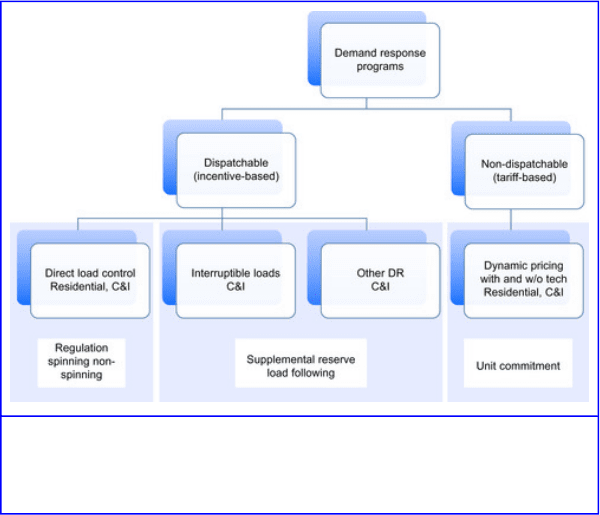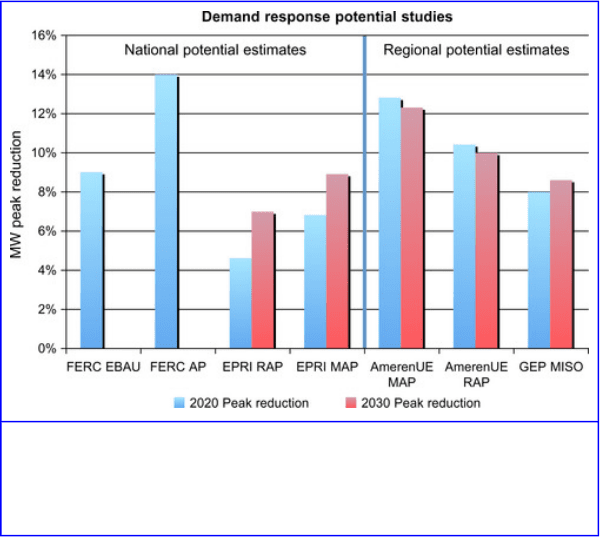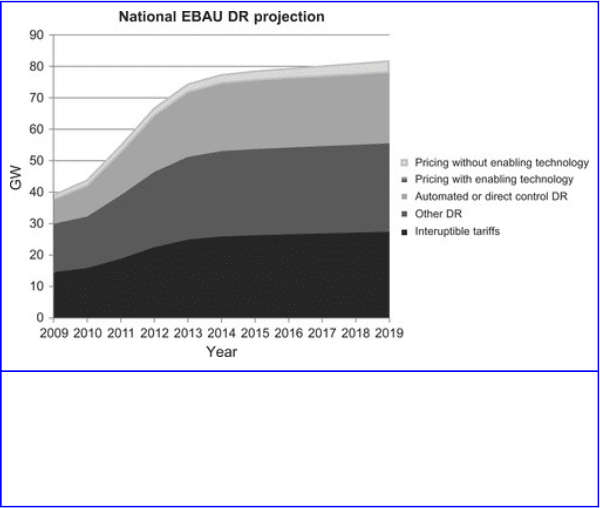Sioshansi F.P. Smart Grid: Integrating Renewable, Distributed & Efficient Energy
Подождите немного. Документ загружается.

Minimizing regulation and load-following integration costs is,
of course, also essential to maximizing wind capacity
integration. It is worth noting that Figure 9.7 is a
representation of integration costs, not capacity. Therefore,
since the price of regulation is several times that of other
services, the cumulative MWs of required regulation are an
even smaller fraction of the ancillary MWs required to
integrate wind. The annual average price ($/MWh) of
regulation up and down is typically two to ten times that of
spinning reserves and twenty to thirty that of non-spinning
reserves [28].
The clear trend among the studies surveyed is that
unit-commitment costs account for the majority of operational
costs associated with VER integration. While there are
exceptions, these are typically attributable to variations in
accounting methodology employed by the study authors. For
example, the Avista study, which focused on wind integration
in the Pacific Northwest region, attributes the largest fraction
of integration costs to load-following services [29]. This
anomaly is driven by the study's mingling of wind forecasting
error with load-following requirements. Wind forecasting
errors generally fall into the unit-commitment bin, although
some amount of intra-hour forecasting errors falls into load
following as well.
Strategies for decreasing regulation and load-following
integration costs are less extensively documented than those
of unit commitment. Utilizing DR to firm VERs through
ancillary services provides such a strategy.
471

Demand Response Resource Topology
To examine the relative merits of various DR resources
classes and their suitability for VER integration-driven
applications, it is helpful to deconstruct the panoply of DR
resources into a finite framework disaggregated by relevant
metrics. Figure 9.8 presents a topology of DR resources that
is framed in terms of resource dispatchability and ancillary
service timescale. Because VER integration is dissected into
the timescales necessary to attribute incremental operational
costs into discrete ancillary markets, it is instructive to frame
the DR resource topology in the same way.
Figure 9.8
Demand response resource topology.
Because of typical latencies, tariff-based DR programs are not
suitable for dispatch on timescales relevant to daily reliability
472
concerns. The price structure of these programs can be
tweaked to optimize the unit-commitment process with VERs.
In a simplified sense, this amounts to charging more for
electricity when demand is high and the system is strained.
Dynamic pricing with enabling technology refers to rate
structures that offer customers time-varying electricity prices
on a day-ahead or real-time basis. Dynamic pricing without
enabling technology refers to the same program structures,
but without the appropriate technology to automate
price-response behavior.
One important drawback of price-responsive DR is that the
marginal contribution to system reserves declines with
penetration [30]. In other words, the effective load-carrying
capability (ELCC) of economic DR is subject to the law of
diminishing returns as a reliability asset. Conversely, truly
dispatchable DR can be controlled directly by the system
operator and can therefore theoretically achieve an effective
load-carrying capacity of up to 100%. This means that, in
reliability terms, dispatchable DR resources could potentially
be valued at the same level as thermal generating capacity.
The next level of the DR topological tree distinguishes the
five classes of DR type outlined in FERC's National
Assessment of Demand Response Potential [31]. Interruptible
tariffs refer to DR programs where customers agree to reduce
consumption during system reliability problems in return for
incentive payments. These programs are typically only
available for large commercial and industrial customers.
Interruptible tariff DR resources are dispatchable with time
spans ranging from seconds to hours, implying the ability to
bid into both regulation, spinning, and load-following
ancillary service markets [10]. Other DR programs refer to
473
capacity bidding, demand bidding, and other aggregator
offerings to medium and large commercial and industrial
customers. Some of these programs are price triggered, while
others are triggered by reliability events. For the purposes of
this analysis other DR programs are considered to be
dispatchable with time spans ranging from hours to days.
Direct load control (DLC) refers to customer end uses that are
directly controlled by the utility or third-party aggregators and
are shut down or moved to a lower consumption level as the
market dictates. A wide range of DR resources exist that
could be utilized by DLC programs. Residential DLC
resources include water heating, pumping loads, refrigerators
defrost cycles, battery charges for consumer electronics,
washing machines, lights, and stoves. Commercial DLC
resources include air conditioners, heat pumps, refrigerated
warehouses, electric water heaters, dual-fuel boilers, HVAC
systems with thermal storage, and lighting. Industrial DLC
resources include induction and ladle metallurgy furnaces, air
liquefaction facilities, gas and water pumping, agricultural
irrigation, aluminum smelting, and various electrolysis
facilities such as chlor-alkali, potassium hydroxide,
magnesium, sodium chlorate, and copper [15].
In the commercial and residential sectors, DLC loads are
often modeled as what a building owner can submit to DR
markets, such as air conditioning for spinning reserves.
However, DLC potential from the tenant's perspective is often
overlooked. Tenants of large commercial buildings represent
a vast potential DR resource that could be accessed by means
of competitive DR bidding processes. During the Empire
State Building retrofit, Johnson Controls Inc. discovered that
it was able to submit 5% of a 10 MW peak load to DR
474
programs from centrally controlled devices. When tenants
were allowed to collectively bid into DR programs, facilitated
by the building's management, DR capacity grew to 25% of
building peak load.
2
During extreme reliability events, when
incentive payments were at their peak, tenants were literally
“unplugging copy machines.” This five fold increase is just
one anecdotal example of the tremendous savings inherent in
opening up DR facilitated through tenant bidding as opposed
to solely building manager response.
2
Based on conversations with Paul Rode, Senior Project Manager of the
Empire State Building energy retrofit.
The final level of the DR topological tree in Figure 9.8 shows
the ancillary services relevant to the class of DR on the basis
of the response latency. Since VER integration costs are
binned into the same market structure, this facilitates a
comparison of DR resource potential and integration
requirements. By treating the structure of ancillary services
markets as the interface between DR resource potential and
VER integration costs, one can estimate the extent to which
DR can enable high penetration of wind and solar. Building
on the central metaphor of a flexibility supply curve, the
framework provided by this type of topological categorization
of DR resources elucidates the width, and potentially the
height, of the DR portion of that curve.
It is important to note that interruptible tariff DR programs
are well suited to manage reliability-constrained
load-following ramps of wind-down and load-up. These
scenarios are less frequent than the economically constrained
ramps of wind-up, load-down that are well suited to forward
capacity DR programs (other DR).
475
This final level of the resource topology reveals that DLC is
well positioned to meet the incremental ancillary service
requirements imposed by large-scale deployments of variable
renewables. The ability of DLC to be dispatched within short
timescales allows it to provide non-spinning, spinning, and
even regulation services that account for the lion's share of
integration requirements (Figure 9.7). Hindsberger et al.
describe how DLC can provide frequency regulation in
Chapter 19.
Demand Response Potential Assessment
Because DR is used primarily for reliability applications in
current markets, resource potential is typically expressed in
units of capacity. Peak load reduction is especially relevant
for reliability and peak shaving applications; thus a metric of
% MW peak reduction is appropriate. A relevant metric for
economic DR might be ELCC. The ELCC metric is defined
as the amount of new load that can be added to a system after
a new unit is added without increasing the system's loss of
load expectation above its initial value [30]. The adoption of
this method is encumbered by the fact that the calculation of
ELCC is more computationally intensive than alternative
methods. In addition, because ELCC is a highly non-linear
quantity that embodies a broad set of system characteristics,
the results are very location dependent, with limited
comparability across systems. Nevertheless, capturing the true
capacity value of DR resources will be increasingly important
as applications for load flexibility evolve.
A comparison of several DR potential studies surveyed
indicates that DR could reduce system peak load by roughly
between 5 and 15% (Figure 9.9). Although the range of
values is relatively large, even in the most conservative case,
476

DR has the potential to offset a large fraction of load. Notably
however, the most detailed, bottom-up estimates of resource
potential provide the largest estimates, which suggests DR's
true potential lies closer to the top of this range.
Figure 9.9
Peak shaving estimates from existing demand response potential studies.
Authors compiled from FERC [31], GEP [33] and [34].
EPRI's “Assessment of Achievable Potential from Energy
Efficiency and Demand Response Programs in the United
States” represents the most conservative estimate of DR
deployment potential. EPRI's model considers the impact of
energy efficiency on peak savings before evaluating DR. This
arbitrary loading order creates an energy efficiency peak
shaving bias. The residential and commercial sectors were
modeled bottom-up with GEP's loadMAP model, while the
477
industrial sector was modeled top-down with data from the
Energy Information Administration's 2008 Annual Energy
Outlook. Direct load control measures modeled include
personal electronics, refrigerators, air conditioners (C&I and
residential), residential water heating, commercial lighting,
and other, unspecified industrial DLC processes [32].
“The AmerenUE DSM Market Potential Study” provides a
Midwestern region focus, as opposed to the national EPRI
estimate. The study models the residential and C&I sectors
from the bottom up, as opposed to EPRI's top-down
econometric method for the industrial sector [33], and, like
the EPRI study, utilizes the Global Energy Partners
LoadMAP model. EPRI's Midwest economic potential in
2030 is 12.3% while AmerenUE's economic potential is
16.6%, reflecting a more extensive list of energy-efficiency
measures. However, EPRI's Midwest realistic achievable
potential is 7.5% in 2030, compared with 7.3% for
AmerenUE. The dramatic drop in AmerenUE's achievable
potential is attributed to stark market acceptance rates. In
particular, direct load control DR potential estimates include
only residential water heating and air conditioning.
“The Global Energy Partners Assessment of Demand
Response and Energy Efficiency Potential for the Midwest
ISO” provides another bottom-up assessment of demand-side
management potential [34]. Data were provided by local
utilities where available, but did not incorporate state energy
efficiency (EE) portfolio standards (Illinois, Indiana,
Michigan, Ohio). This report assumes stagnant EE and DR
growth by 2020, corresponding to the untenable assumption
of when, if ever, market saturation will occur. The AmerenUE
report assumes a similar inflection point for EE and DR
478
potential. The largest DLC DR potential corresponds to
residential air conditioning and hot water heating,
representing 93% of DLC potential in 2030. Commercial
DLC programs make up the remaining 7%, although
industrial DLC potential was not modeled.
FERC's “National Assessment of Demand Response
Potential” is the most comprehensive state-by-state database
of DR potential yet developed. The report estimates the
amount of DR that could be deployed based on the number of
participating customers, availability of dynamic pricing,
advanced metering infrastructure, the use of enabling
technologies, and varying responses of different customer
classes [31]. These scenarios are Business-as-Usual,
Expanded Business-as-Usual, Achievable Participation, and
Full Participation.
This analysis focuses on the Expanded Business as Usual
(EBAU) and Achievable Potential (AP) scenarios of the
report as a credible range for DR deployment. The Business
as Usual scenario assumed no additional growth beyond
current participation levels, which is clearly not credible in
light of current market growth. Likewise, the Full
Participation scenario assumes a level of dynamic pricing
program adoption not likely in the current market
environment.
FERC's EBAU scenario departs from the BAU scenario by
assuming “best practice” participation levels for the current
mix of DR (Figure 9.10). Partial deployment of AMI and a
small number of customers (5%) choosing dynamic pricing
DR programs are also assumed. Of the panoply of DLC loads
described in this report, only three were considered in FERC's
EBAU DLC modeling: residential and commercial air
479

conditioning and irrigation loads in a few states.
Consequently, FERC's EBAU DLC potential is a relatively
conservative estimate of available DLC potential.
Figure 9.10
FERC's EBAU scenario disaggregated by program type with increasing
participation levels in current DR programs.
Source: FERC [31]
FERC's Achievable Participation scenario assumes that AMI
infrastructure is universally deployed by 2019, that a dynamic
pricing tariff becomes the default, and that 60–75% of
customers stay on dynamic pricing rates. The key difference
between the EBAU and AP scenario is the potential peak
reduction unlocked by dynamic pricing DR programs enabled
through AMI. The initial growth of IT, DLC, and other DR
programs closely tracks the EBAU scenario for the first few
years until pricing programs take off with AMI deployment.
480
